The heroine of the memoir of a love affair wears a classic by Dior, from 1947.
Showing posts with label miss dior. Show all posts
Showing posts with label miss dior. Show all posts
Sunday, March 29, 2020
Friday, November 8, 2013
Dior Dedicates an Exhibition to Miss Dior perfume
Christian Dior's first perfume created in 1947, Miss Dior becomes for the first time the subject of a dedicated exhibition that highlights the heritage of the venerable house. From November 13 to 25 at the Curve Gallery at the Grand Palais in Paris, the exhibition "The Spirit of Dior Miss Dior", reveals the creations of five female artists designed around the fragrance. Each work is thus based on a symbol of Miss Dior, such as the bow, the rose or the perfume's muse, actress Natalie Portman. Mythical signed Dior dresses, but also contemporary works of Raf Simons will punctuate the visit.
It is here important to note that Dior is sequencing the story in such a way as to present a somewhat different perfume composition (the formerly "Miss Dior Cherie" now changed into simply "Miss Dior") as the heir of the original creation from 1947 (sold now as "Miss Dior Originale" for dedicated fans). The curating of an artistic exhibition in such a way tries to mingle history and marketing in a way that highlights the heritage of the house as its prime selling vantage point. In a way this is what the revamped Dior site is trying to accomplish as well.
Beyond the story of the perfume, nevertheless, the exhibition at the Grand Palais sketches a portrait of Christian Dior the man, revealing the artistic influences of the designer who began his career as an art dealer in Paris. The loft space then includes works by Salvador Dali and Man Ray. The history of the House of Dior is also traced through original documents, manuscripts and rare photos. The objects are grouped, each time accompanied by an iconic Dior couture gown. Those with an eye for fashion history won't be disappointed.
"The Spirit of Dior, Miss Dior" is free for the public.
From November 13 to 25 at the Curve Gallery at the Grand Palais in Paris, 11am to 8pm.
Related reading on Perfume Shrine:
Miss Dior (Originale) fragrance review,
Chronology and Comparison of Fragrance Editions of Miss Dior,
Christian Dior news & reviews.
It is here important to note that Dior is sequencing the story in such a way as to present a somewhat different perfume composition (the formerly "Miss Dior Cherie" now changed into simply "Miss Dior") as the heir of the original creation from 1947 (sold now as "Miss Dior Originale" for dedicated fans). The curating of an artistic exhibition in such a way tries to mingle history and marketing in a way that highlights the heritage of the house as its prime selling vantage point. In a way this is what the revamped Dior site is trying to accomplish as well.
Beyond the story of the perfume, nevertheless, the exhibition at the Grand Palais sketches a portrait of Christian Dior the man, revealing the artistic influences of the designer who began his career as an art dealer in Paris. The loft space then includes works by Salvador Dali and Man Ray. The history of the House of Dior is also traced through original documents, manuscripts and rare photos. The objects are grouped, each time accompanied by an iconic Dior couture gown. Those with an eye for fashion history won't be disappointed.
"The Spirit of Dior, Miss Dior" is free for the public.
From November 13 to 25 at the Curve Gallery at the Grand Palais in Paris, 11am to 8pm.
Related reading on Perfume Shrine:
Miss Dior (Originale) fragrance review,
Chronology and Comparison of Fragrance Editions of Miss Dior,
Christian Dior news & reviews.
Tuesday, February 19, 2013
Miss Dior La Vie en Rose: new campaign for Dior's best-selling fragrance
It doesn't matter that Dior's Miss Dior perfume is a travesty on a thousand levels (the fragrance started out being called Miss Dior Cherie, it changed its formula into being unrecognizable, it took the name of the original 1947 Miss Dior perfume confusing consumers etc. etc; click on Miss Dior vs Miss Dior Cherie differences article to find out the whole truth). A new campaign is a new campaign nevertheless (starring Natalie Portman again, the premise for the new, more "serious" love angle they're pitching) and it will have tongues wagging, no doubt. Especially since Sofia Coppola is directing (i.e. the woman who was responsible for the delightful and oh-so-fun original Miss Dior Cherie campaign with a flirty Marina Linchuk set to Bardot's "Moi, je joue" tune years ago).
Here are the teasers, the whole commercial will air on February 24th.
I assume the line "Christian Dior said" refers to the Dior fragrances brand and not the actual designer...(who had been dead long before Miss Dior (Cherie) was even a spermatic thought at anyone's mind). Ah well, chalk it up into harmless fluff and enjoy the visuals.
"When he takes me in his hands...
...and whispers love to me...
...everything's lovely. It's him for me and me for him...
...all our lives, and it's so real what I feel, that's why."
The teasers are code-named "the fountain" (la fontaine), "the car ride" (la voiture), "the kiss" (le baiser) and "the garden" (le jardin).
Here are the teasers, the whole commercial will air on February 24th.
I assume the line "Christian Dior said" refers to the Dior fragrances brand and not the actual designer...(who had been dead long before Miss Dior (Cherie) was even a spermatic thought at anyone's mind). Ah well, chalk it up into harmless fluff and enjoy the visuals.
"When he takes me in his hands...
...and whispers love to me...
...everything's lovely. It's him for me and me for him...
...all our lives, and it's so real what I feel, that's why."
The teasers are code-named "the fountain" (la fontaine), "the car ride" (la voiture), "the kiss" (le baiser) and "the garden" (le jardin).
Thursday, November 15, 2007
The Dior Chypres series ~Miss Dior: fragrance review

Almost everything has been said about this classic of classics that saw the light of day in 1947, so I won’t bore you with the same old, same old about the New Look and how it came about. Instead I will tentatively try to give you the feel I get from this scent and the associations I get in my mind.
Technically a floral leathery chypre, Miss Dior is a soigné miss only in exterior appearances, all prim and proper, because once inside the beast takes over and you smell the animal in its peak of copulating frenzy. There is some element of appocrine in the fragrance and I am not talking about sweat or urine. Although there is the clean overlay of aldehydic waxiness and soft flowers you catch a whiff of more feral, impolite essences. Under the clean exterior there is the carnal cat-call and you feel as if it is perhaps too scrubbed clean to be without ulterior motive. I suspect this is due to civet or civetone, because there is also a pronounced warmth in the background, despite the cooler opening.
The effect is more evident in extrait de parfum especially, which bears a marked difference to the eau de toilette. The latter is more powdery with the slightly bitter, cottony feel of coumarin and has an exuberant, bright green start due to the inclusion of galbanum and aromatic clary sage. Those two ingredients, along with styralyl acetate (naturally found in gardenia buds), is what makes me think of the original Ma Griffe by Carven to which it professes kinship in its initial stages. The galbanum touch might also recall the verdancy of Balmain’s Vent Vert (which came out the same year), although the latter is stridently green in the vintage edition which might seem jarring compared to Miss Dior. The latter also has a soft peachiness to it, characteristic of the Roudnitska touch presumely, which must be derived from some aldehydic compound or other molecular combination, different though from the C14 of Mitsouko. It is a peachiness that I have encountered in hair products, hence my assumption that it is chemically constructed.
The base is smothered in troubling patchouli, moss and earthy vetiver. However this is not the pared down patchouli of modern fragrances that is so ubiquitous in everything churned out at a frantic pace in the last couple of years. There is shady vibrancy in this that defies the clean aspect of the modern patchouli interpretations and a roundness in which notes do not compete with each other for stage space.
As I first inhale whiffs of Miss Dior sprayed into the air, I am transported into a mirage that entails majestic mountains surrounding meadows of lavender and narcissi in bloom, where ultra prim damsels wade through. Their long flaxen hair down, their eyes bright with anticipation in their precious moments of freedom as they turn past oak trees into a little slice of heaven; a pond filled with crystalline waters. And there, out of the blue emerges the catalyst: the object of fantasy and secret longing of who knows what exactly. Acres of moist skin, droplets shinning in the morning sun and wet hair that smells like it hadn’t been washed in a while; that fatty, waxy smell of familiarity, yet for them uncharted territory still. The pungency of horse and saddle distantly echoed in the background.
Here it is:
(Levis commercial uploaded by ladynea)
{The song is "Inside" by one-hit wonder Stiltskin (from 1994)}.
Christian Dior confided that
"...I created this perfume to dress every woman with a trail of desire, and to see emerging from her small bottle all my dresses...”.Based on a formula by Jean Carles, it was composed by Paul Vacher and later re-arranged in 1992 by Edmond Roudnitska in extrait de parfum. It hoped to open new vistas of optimism after the privations of the war and in a way it did.
Unfortunately, as is so often the case with older creations, there has been some re-orchestration of Miss Dior’s symphony since. Very recent batches do not smell as oily and precise as they did, due to a mollifying of the top notes that deducted the sharp peppery greeness of galbanum giving way to a citrus leaf aroma, not unlike the one in O de Lancome. Also an attenuation of the chypre accord with more vetiver makes the new version less assertive and murky than it used to, rendering it less erotic in effect. At least Evernia Prunastri (oakmoss) and Evernia Furfurea (tree moss) are still listed, although to what ratio it is unknown (hypothesized to a lesser one).
If you happen upon Eau de Cologne bottles, those are surely vintage and they are a pretty good acquisition in lieu of extrait de parfum, if you can’t afford or find it.
It is interesting to note that by today’s standards Miss Dior smells “old-fashioned”, even though it was conceived as a young fragrance aimed at debutantes. Less polite souls would baptize it “old lady”, a blanket term so lacking in qualitative nuance that renders it completely useless. Indeed I was able to witness its effect personally. I happened to spritz a vintage (circa 1985) emerging from a ladies’ restroom, washing in front of two teenager girls who were watching me through the mirror while glossing their puckered lips. Aren’t those times tittilating for budding womanhood? Of course I volunteered to scent them, ever eager to introduce young girls into proper perfumes. One of them staggered back in what seemed like abject horror (judging by the look in her eye) professing the opinion it was “too heavy for her”, the other was more cooperative and allowed me two spritzes on her woolen scarf. Although at first she too seemed a little overwhelmed, after a minute, when alcohol had evaporated, she took the scarf close to her nose and nuzzled deeply. Yeah, there was a look of mischief in her eye as she thanked me. And there you have it: Miss Dior has this double effect; it will make some think it’s heavy and old, it will entrance others on second sniff. I am sure that girl went off to venture into romantic escapades with ackward beaux that could not appreciate the raw power of its labdanum and moss base; beaux whose fathers will be much more receptive to her nubile charms, American-Beauty-style.
Miss Dior is the scent of sexual awakening. A trully naughty perfume under the prim and proper exterior of houndstooth. But hounds do discover the best prey, don’t they?
Official notes: galbanum, bergamot, clary sage, gardenia, jasmine, narcissus, neroli, rose, patchouli, oakmoss, labdanum, sandalwood
NOTA BENE: The above review pertains to the 1947 fragrance formula and the reformulations happening till the early 2000s. As of 2011, the classic Miss Dior is renamed Miss Dior EDT Originale and Miss Dior Cherie from 2005 has become simply... Miss Dior. Please read this article with pics on how to spot which Miss Dior fragrance version you're buying.
For our French-speaking readers there is a nice clip about the 1947 introduction of the New Look with a confessionary voiceover by Fanny Ardant.
Click here:
(uploaded by vodeotv)
We have more surprises on the Shrine for you later on...

Sunday, November 11, 2007
Dior sketch ads: how lovely!
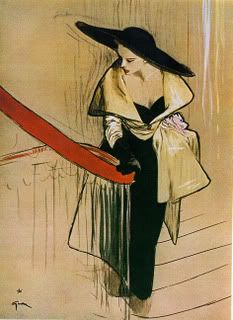
Here is his obuitary from the Guardian:
"René Gruau (Count Renato Zavagli Ricciardelli delle Camminate), graphic artist, born February 4 1909; died March 31 2004" (from the Guardian 15 April 2004)Guardian obituaries
It says so little...In fact it was exactly Gruau that persuaded Dior to accept the offer of textile magnate Marcel Boussac to help establish a fashion house. After all not many know that Christian Dior began as an illustrator himself. The rest is of course history.
Born in Rimini, Italy, in 1910 as Renato Conte de Savagli-Ricardelli, he had a French mother, Marie Gruau, who was known as a great beauty and must surely be held responsible for providing the son with his first glimpse of beauty that culminated in his vision and aesthetic explorations.
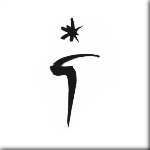
Using a heavier charcoal outline or thick paint brush was his signature look at an era that preferred watercolours and delicate delineations. It was his modernity that differentiated him and which was a companion till the very end, making his work seem current even today in a world that has practically seen everything.
Apart from Dior he also did illustrations for Balmain, Lanvin, Schiaparelli and his favourite, Balenciaga. He was also instrumental in trying to give a younger image to Givenchy couture. Not to forget his work for films (who can forget his "La Dolce Vita" or "French CanCan" art posters?)and for "glossies": Flair, Vogue and Harper's Bazaar. His provision for Moulin Rouge and Lido remind us of another famous artist of posters with arguably low subjects turned into high art: Toulouse-Lautrec.
But his work for Dior parfums is crystallised someplace in the best part of perfume lovers' mind.
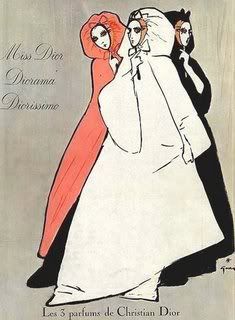
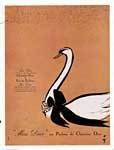
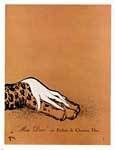
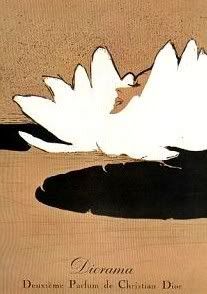
Gloriously simple, gloriously evocative.
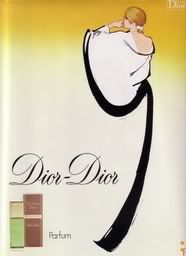
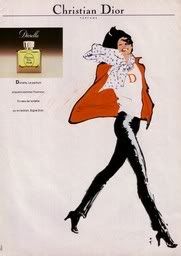
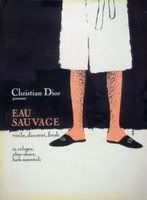
Less intriguing than the previous incarnation, but just as playful.
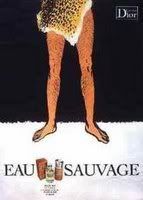
A great artist and a witty man, to be sure.
If I have persuaded you to take an interest in this artist's work, take a moment to revel in these glorious fashion sketches....
We will continue with the Dior chypres shortly. Stay tuned!

Monday, November 5, 2007
The Dior Chypres series ~1.the hidden force: Edmond Roudnitska
Perfume Shrine embarked on a mission: to disect and discuss one of the bastions of chypre: la maison Dior in its former glory, when under the baguette of Edmond Roudnitska and Paul Vacher it produced classics that remain up there in the pantheon for all of us to worship.
Edmond Roudnitska is probably the one name you simply need to drop if you want to appear as if you have at least a passing knowledge of scent. Of course name dropping is completely ridiculous, especially when used to prove that someone knows anything about anything, but the practice does not diminish the value of this Ukranian émigré who started as an assistant to Ernest Beaux; the Russian perfumer to the czars who made the legend of Chanel parfums almost single-handedly. Did his apprenticeship serve him well? More than that.
Roudnitska became much more than an artist of high calibre in the fragrant galaxy or a point of reference. He also pondered theoretically on the subject of perfume through his prolific writing and his polemic to establish perfume creation as an art form, especially in his book “Le parfum” in the “Que sais-je?” series (now out of print), “L’ésthetique en question” and “L’intimité du parfum”. But the dialectic he inaugurated has survived in his dictum (from a speech given on 20 November 1952 in Paris):
For him it is not the sense of smell or the materials that are important, but rather the spirit which, playing with forms, will coax the latter with the aid of the former. This point of view had been forgotten for decades when perfumes came out with the eye more on the commercial than the artistic, only to be revived when certain niche companies came into the fore dynamically. Roudnitska bases his axiom in the comparison to other art forms (as mapped out by Etienne Souriau).
One criterion is the pre-thought-out process that precedes composition, contrasting popular myths about “happy accidents” (too much aldehydes in Chanel No.5, vanillin in Jicky producing the basic accord for Shalimar) and certainly the rumour that Jean Carles composed by instinct rather than plan. Therefore artistic perfume composition should focus in evoking odours in an abstract manner. In this he found an eminable successor in Jean Claude Ellena who composes with pen and paper at hand and not concocting alloys at some secret lab. Emphasis on the interaction of materials with one another is also highly regarded.
Additionally, perfume composition should be unique, much like a musical piece, and protected against “plagiarism”. To this he was adamant. He would be sadly disillusioned to find out that nowadays there are hundreds of fragrances that are composed with gas chromatograph and mass spectometer at the side of the unlucky recipient of a perfume brief from a big company: that is, to replicate a best-selling fragrance adding a minimal twist. This is where the education of the public comes into the fore, as well as the possibility of expression both personal and national or era-related through perfume.
Perhaps one of Roudnitska’s best known triumphs -alongside Diorissimo, the iconic lily of the valley fragrance- is the classic Rochas chypre Femme {click here for review}. In this he explored the concept of the fruity chypre with touches of aldehyde and powder rendering a fragrance at once opulent, alluring and elegant. Himself he renounced the moniker of “chypre” for it. In an article appearing in Perfumer and Flavorist magazine in December 1987, he describes Femme as
But it was his meeting with Serge Heftler-Louiche, director of parfums Christian Dior that cemented his style and directed him into a lucrative business and artistic collaboration that lasted for decades and it is interesting to juxtapose the chypres he produced for them with Femme. Christian Dior opened shop in 1945 under the insistence of the businessman Marcel Boussac. A new perspective to fashion was brought with his New Look, which took women back to the era of crinolines, in a way, counter-revolutionising what Cadolle and Chanel had accomplished through the use of pliable materials that helped women become the men in their lives in all areas besides the boudoir. Dior envisioned women in more traditional roles, wasp-waisted like some Minoan goddess and with meters of skirt lengths that challenged the rationed days of the war:
The year was 1947 and Dior came out with his first scent, Miss Dior, as homage to his sister. Credited to Paul Vacher, based on a formula suggested by Jean Carles and reorchastrated by Roudnitska in 1992 in extrait de parfum, it is nothing short of a classic and the introduction of a big trend in the coming years: the floral chypre; but with an animalic twist down the line, of which more later on.
But it was in 1949 that Diorama, a fruity chypre perfume, was created by Roudnitska. With it he found a balance between complexity and clear vision that captures several olfactory nuances: spicy, floral, fruity, animalic and all enrobed in a sensual feminine dress. By this time he began simplifying his palette, making stricter formulae, with a mathematical precision that abandonded notes that served merely for the pleasantry of the senses, like heavy sugary ones, to focus on more spiritual endeavours using purer, strictly “olfactory” notes that aimed at the cerebral rather than the carnal; aiming at elevating scent from the instinct of the reptile cortex into the fully developed Homo sapiens membranes. Eau d’Hermès followed in 1951, all spices galore, and Eau Fraîche for Dior in 1953, comissioned and modeled around Coty’s Cordon Vert eau de cologne (in its turn by Chypre) and by Roudnitska’s own words the only true chypre version in the market (this was in 1993).
In 1963 Paul Vacher produced another chypre in the Dior stable: this time a leathery fragrance, Diorling. With it all elements fall into place into a supreme elegance that is as buttery smooth as the fur of an alpaca coat.
Roudnitska’s most successful –commercially certainly! - scent entered the scene in 1966: Eau Sauvage. A chyprish citrus for men with the daring floral note of jasmine through the use of hedione. In this Roudnitska culminated his aesthetic odyssey of the sparseness of composition with an artistic merit that defies criticism. Diorella (1972), with its foot in the fruity tradition of Diorama, was the feminine chypre counterpart to Eau Sauvage, enigmatically relying on very few materials to give a very fresh, very young fragrance and which Roudnitska himself considered one of the best in his career. Dior Dior, a woody floral perfume, issued in 1976, never took off commercially and was destined to be discontinued till now.
Luckily Diorama and Diorling, two of the pre-eminent chypres in the Dior constellation have been re-issued and will be reviewed shortly along with the other Dior chypres.
Related reading on PerfumeShrine:
The Dior series, fragrance reviews of classic perfumes
Pic of E.Roudnitska courtesy of artetparfum, Dior ad from parfumsdepub. Translations of quotes from the French by Elena Vosnaki
Edmond Roudnitska is probably the one name you simply need to drop if you want to appear as if you have at least a passing knowledge of scent. Of course name dropping is completely ridiculous, especially when used to prove that someone knows anything about anything, but the practice does not diminish the value of this Ukranian émigré who started as an assistant to Ernest Beaux; the Russian perfumer to the czars who made the legend of Chanel parfums almost single-handedly. Did his apprenticeship serve him well? More than that.
Roudnitska became much more than an artist of high calibre in the fragrant galaxy or a point of reference. He also pondered theoretically on the subject of perfume through his prolific writing and his polemic to establish perfume creation as an art form, especially in his book “Le parfum” in the “Que sais-je?” series (now out of print), “L’ésthetique en question” and “L’intimité du parfum”. But the dialectic he inaugurated has survived in his dictum (from a speech given on 20 November 1952 in Paris):
“For it to be considered Art, smell ceases to be a sense to be satisfied to rather become a medium. Thus perfumes will be spiritual compositions and the public will be able to initiate themselves into olfactive forms”.
For him it is not the sense of smell or the materials that are important, but rather the spirit which, playing with forms, will coax the latter with the aid of the former. This point of view had been forgotten for decades when perfumes came out with the eye more on the commercial than the artistic, only to be revived when certain niche companies came into the fore dynamically. Roudnitska bases his axiom in the comparison to other art forms (as mapped out by Etienne Souriau).
“A beautiful perfume is the one which gives us a shock: a sensory one followed by a psychological one. A beautiful perfume is one with happy proportions and an original form”.
One criterion is the pre-thought-out process that precedes composition, contrasting popular myths about “happy accidents” (too much aldehydes in Chanel No.5, vanillin in Jicky producing the basic accord for Shalimar) and certainly the rumour that Jean Carles composed by instinct rather than plan. Therefore artistic perfume composition should focus in evoking odours in an abstract manner. In this he found an eminable successor in Jean Claude Ellena who composes with pen and paper at hand and not concocting alloys at some secret lab. Emphasis on the interaction of materials with one another is also highly regarded.
Additionally, perfume composition should be unique, much like a musical piece, and protected against “plagiarism”. To this he was adamant. He would be sadly disillusioned to find out that nowadays there are hundreds of fragrances that are composed with gas chromatograph and mass spectometer at the side of the unlucky recipient of a perfume brief from a big company: that is, to replicate a best-selling fragrance adding a minimal twist. This is where the education of the public comes into the fore, as well as the possibility of expression both personal and national or era-related through perfume.
Perhaps one of Roudnitska’s best known triumphs -alongside Diorissimo, the iconic lily of the valley fragrance- is the classic Rochas chypre Femme {click here for review}. In this he explored the concept of the fruity chypre with touches of aldehyde and powder rendering a fragrance at once opulent, alluring and elegant. Himself he renounced the moniker of “chypre” for it. In an article appearing in Perfumer and Flavorist magazine in December 1987, he describes Femme as
“floral, aldehydic and very fruity, with the double characteristic of woodiness and sweetness”.This was due to the antithesis to Coty’s prototype but probably also due to a desire to differentiate from previous fruity exempla, such as Mitsouko. Roudnitska continued to produce scents for Rochas: Mouselline (formely Chiffon), Mouche, Moustache and La Rose.
"We were emerging from a period of war, uniforms, female soldiers built like boxers. I was drawing female flowers with soft shoulders, full busts, waists as slim as liana and corolla skirts".Carmel Snow, editor-in-chief of Harper’s Bazaar remarked:
“It's quite a revolution, dear Christian. Your dresses have such a new look”.
The year was 1947 and Dior came out with his first scent, Miss Dior, as homage to his sister. Credited to Paul Vacher, based on a formula suggested by Jean Carles and reorchastrated by Roudnitska in 1992 in extrait de parfum, it is nothing short of a classic and the introduction of a big trend in the coming years: the floral chypre; but with an animalic twist down the line, of which more later on.
But it was in 1949 that Diorama, a fruity chypre perfume, was created by Roudnitska. With it he found a balance between complexity and clear vision that captures several olfactory nuances: spicy, floral, fruity, animalic and all enrobed in a sensual feminine dress. By this time he began simplifying his palette, making stricter formulae, with a mathematical precision that abandonded notes that served merely for the pleasantry of the senses, like heavy sugary ones, to focus on more spiritual endeavours using purer, strictly “olfactory” notes that aimed at the cerebral rather than the carnal; aiming at elevating scent from the instinct of the reptile cortex into the fully developed Homo sapiens membranes. Eau d’Hermès followed in 1951, all spices galore, and Eau Fraîche for Dior in 1953, comissioned and modeled around Coty’s Cordon Vert eau de cologne (in its turn by Chypre) and by Roudnitska’s own words the only true chypre version in the market (this was in 1993).
In 1963 Paul Vacher produced another chypre in the Dior stable: this time a leathery fragrance, Diorling. With it all elements fall into place into a supreme elegance that is as buttery smooth as the fur of an alpaca coat.
Roudnitska’s most successful –commercially certainly! - scent entered the scene in 1966: Eau Sauvage. A chyprish citrus for men with the daring floral note of jasmine through the use of hedione. In this Roudnitska culminated his aesthetic odyssey of the sparseness of composition with an artistic merit that defies criticism. Diorella (1972), with its foot in the fruity tradition of Diorama, was the feminine chypre counterpart to Eau Sauvage, enigmatically relying on very few materials to give a very fresh, very young fragrance and which Roudnitska himself considered one of the best in his career. Dior Dior, a woody floral perfume, issued in 1976, never took off commercially and was destined to be discontinued till now.
Luckily Diorama and Diorling, two of the pre-eminent chypres in the Dior constellation have been re-issued and will be reviewed shortly along with the other Dior chypres.
Related reading on PerfumeShrine:
The Dior series, fragrance reviews of classic perfumes
Pic of E.Roudnitska courtesy of artetparfum, Dior ad from parfumsdepub. Translations of quotes from the French by Elena Vosnaki
Monday, October 8, 2007
Chypre series 5: chronology and the zeitgeist

Thus, chypre fragrances evolved through a particular cultural necessity that alternately dictated allegience to forces of cool earthiness, or feminine powderiness or elegant sophistication. Although chypres have been in existence since antiquity, as previously discussed, it is most fascinating to contemplate their evolution in the 20th century.
Contrary to popular perception, François Coty was not the first to associate the name Chypre with a particular perfume in 1917. Guerlain's Chypre de Paris preceded him by 8 years, issued in as early as 1909. Chypre d'Orsay was the next one to be introduced, in 1912. However it was Coty's that really took off and became an instant commercial success that created traction and a vogue for such heavy "green" perfumes. It was also the year when Caron launched their Tabac Blond, a daring concept at the time, encouraging women to smell like they smoke, considered terribly chic then.
It was the time before the Great War, when disillusionment had not set in and the introduction of the exotic, sensual mystique of the East hadn't budded yet. It would take legendary Mitsouko by, Guerlain in 1919, inspired by a Japanese heroine in the then best-selling novel "La Bataille" to do that. The success of Les ballets Russes under impressario Diaghilev's artistic baguette (who incidentally loved Mitsouko and used it on his hotel curtains) brought on the vogue for orientals in the 1920s, as manifested by the roaring success of khol-eyed Shalimar. Suddenly everything oriental hinted at abandon and sensuality, the forbidden territory in which "flappers", the independent women of the time, marched through with renewed confidence.
Chypres and tobacco scents provided also a backdrop for confidence and individualism that marked this new era in women's emancipation. Long pipes of ebony and ivory were often held in elegant hands that bore the glamorous manicure of the times and the dark lips that recalled Theda Bara. Molinard's Le Chypre was introduced in 1925 and in 1933 Jacques Guerlain launched Sous le Vent to capture the soul of artiste Josephine Baker, the woman who shocked Americans and mesmerised the Paris audiences. (You can read a full review of Sous le vent clicking here).
The leathery chypre of Chanel, Cuir de Russie, was brought out in 1924, using birch tar as the note that skyrocketed it into the realm of utter sophistication.
As the great Crash crashed hopes of affluence and resurgence for the masses,chypres lost some of their cachet in favour of more economical propositions, at least in the United States. However perusing lists of perfume houses from the perior 1919 up to 1949, we see that every one of them had some chypre fragrance listed in their catalogues. Obviously this was a family that was considered sine qua non for perfume makers. It was often that they married the classic chypre accord with flowers, such as rose, jasmine, carnation, heliotrope or geranium, to render a more feminine note.
Contrast this with today's world in which the name Chypre is associated with more obscure or niche fragrance marketers such as Vivienne, Scientex, Arys, Montale, E.N.Z., Peckinsniffs, and Patyke. They take the heritage of Coty's success with them, but they are not at the front row of fashion. On the other hand, maybe the lack of such identical nomenclature in commercial scents has to do with marketing strategies that point to the direction of more original names that would differentiate products from one another among brands (the fact that they are not that differentiated among the offering of the same brand, what with the flankers of 1, 2, light, summer etc. is fodder for another post).
In the difficult years of World War II, it was the genius of Edmond Roudnitska that saw the potential of a long forgotten vat of methyl ionone that smelled of prunes in the factory that he was working trying to find such exciting things as butter substitute and such due to the privations of war. Femme was the dense fruity chypre of 1944 that recalled an upscale confectionary shop and which became the first perfume of couturier Marchel Rochas, a wedding present to his beautiful young bride.
It is interesting to contrast this with the dyke-y creation of nez extraordinaire Germaine Cellier Bandit for Rober Piguet issued in the same year. An ox-feller of a leathery chypre, Bandit was inspired by the panties that models wore exiting the runway; which according to Cellier was "when they let out the best of their femininity". It is no secret that Cellier was a homosexual...
Bandit was a proud creation that unabashedly confirms the aloofness of intense vetiver and patchouli smeared on used leather and with the echo of moss and flowers in the background. One can picture it on an interesting woman or a daring man. They have to be so to begin with, though, and not hoping to graft the image onto themselves through perfume.

Ma Griffe was another post-War chypre, a true masterpiece by nose Jean Carles for the house of Carven. Very powdery dry and quite spicy thanks to the weird note of styrax, Ma Griffe managed to be assertive in its name (it means "my signature", but also "my talon") and supremely sparkly and feminine in its aroma. It marked the introduction of chypres into the arena of professional women. Those were not factory workers of the war or flappers; they were secretaries at the new firms; twin set in place, string of pearls and a slick of lipstick on impecably powdered faces. The psychology of those new chypres talked about women who earned their living by themselves, but did not manifest themselves as sexual predators. There is a sense of detachment and intelligence.
Christian Dior had just launched the New Look in 1947 that took trainloads of fabric to new heights of spending, in an effort to maximise fabric sales but also to inject a hopeful touch into the hearts of women who had bid farewell to the rationed days of the war.( It is an old adage by Yves Saint Laurent that in times of economic shortage couturiers use a bit more fabric to boost the market, whereas in times of economic affluence -such as the 60s- the shorter length is king). Miss Dior became a best-seller and a crowd pleaser that managed not to sit on the fence, but to take an animalistic backdrop and smother it with soft flowers such as gardenia, narcissus, lily of the valley and green touches of galbanum and aldeydes. It spoke of a new elegance and a subdued sensuality that was not aggressive like that of the flappers, but more pedigreed and delicate, yet undeniably naughty underneath especially in the glorious parfum/extrait concentration.
Well into the 50s, chypres were popular. Jolie Madame was another product of Germaine Cellier, in 1953, that reprised the animalic, leathery theme; this time with very green and violety notes that cede to a big box of talcum powder. This is definitely a turn to the more restrained and professional as befited the times.
Cabochard for Gres by Bernand Chant in 1959 was more devil-may-care in attitude. Obviously there were different types of women to be catered for with the era's chypres and this one was destined for those who were powerful and dominant. Madame Gres said she was inspired by a trip to India. The bitter orange opening on spice and leather and the powdery depths beguiled and asserted themselves in the memory of anyone smelling it. Reformulated in later years, it has been irrecovably ruined, I am afraid. It is a pity, as it used to have a very individual character, hard to mimic, although it does bear some relation to another of Bernard Chant's offerings, Aromatics Elixir by Clinique.
In 1961, Guy Robert created Caleche for the house of Hermes, inspired by a fine type of carriage. The quiet resonance of this scent was completely in tune with the times, exuding copious amount of good taste while remaining tame with its sensuality under wraps; a cladestine affair was not in the programme, but should it ever happen it would remain a very well-kept secret. The sparkle of aldehydes mid-way between two trends, floral and chyprish, gave a fizziness that was also popular at the times, imbuing the whole with a feminine touch that was distinctly Parisian.
But the 1960s was a different time. Although they begun in the soft powdwery florals and the aldehydics, soon Mary Quant with the mini, the Beatles and the hippy movement and the ravages of war in Vietnam and the politics of the time swang the pendulum in another direction that meant another mentality in perfume. Nature and the smells of the body were explored in simple oils, headshop ones, such as straight patchouli and aromas that had a "pot" aroma to them. Clearly this was another page.

Diorella was another legendary Roudnitska creation that remains enigmatic and minimalistic to this day. It begun as an attempt to capitalise on the trend of women wearing men's scents, which had started with yet another Roudnitska creation, Eau Sauvage for Dior. Diorella was to be the more feminine sister scent so that women could claim it as their own. Too crisp and fresh with its lemon opening and its fruity greeness for it to be really sensual, but an elegant insouciant fragrance for the young women who wore trousers and set out to rule the world. The latter image was best depicted by Charlie, that best-seller by Revlon (1973), which revolutionised advertising, depicting women in pants for the first time and focusing on the sheer power and confidence that it gave women who didn't need a man to be successful. It was trully revolutionary, at least conceptually!
Aromatics Elixir for Clinique and Alliage for Lauder (both in 1972), Coriandre by Jean Couturier (with the addition of a large percentage of magnolione, a material similar to hedoine but with more of a jasmine quality) and Private Collection by Lauder (both in 1973) and finally Halston in 1975; all saw this new trend take shape.
Interestingly Givenchy brought out Givenchy Gentleman in 1974, a masculine chypre full of pungent patchouli and a true masterpiece of calculated olfactory assault that married tarragon, vetiver and russian leather, showing that men could project the traditional assured image themselves still.
As the decade was coming to an end, the hyber success of spicy oriental Opium meant a new direction that would take the carnal and affluent capitalistic 80s into new avenues of perfume exhibitionism. The sophistication and powderiness of chypres took a backseat to such bombastic examples as Obsession, Giorgio and Poison.
However they did not completely disappear, with cerebral examples that encompassed Ungaro's rosy bombshell Diva in 1982, Niki de saint Phalle (the 1984 creation of a talented sculptor famous for her snakes and bearing those on the bottle), Knowing by Lauder in 1988 (inspired by the smell of pittosporum smelled during holidays in the south of France) and La perla by luxe lingerie brand in 1986.
In the masculine field, Drakkar Noir by Guy Laroche was launched in 1982; a fougere scent (with borrowed elements off the very herbal chypres) that took the name of Viking ships to emphasize masculinity and which sported tangy verbena and lemon rind with a herbal heart of coriander, lavender and juniper berries on bottom notes of patchouli, sandalwood and fir balsam. It proved to be a bestseller in the corporate world of the Wall-Street-decade.
Nevertheless, the most memorable example of the decade in the category of chypres is perhaps Paloma Picasso, Pablo's daughter's foray into perfumery which was imbued with her unique, bold style and matched her Spanish roots and signature red lips: assured. It brought the animalic quality of castoreum into the vogue again interpreting it into a domineering personality that made Montana follow suit with his Parfum de Peau in the blue box in 1986, with its beautiful bottle inspired by the swirling fall of a winged sycamore seed as seen by a strobe light, designed by Serge Mansau. Magnificently intense and terribly potent it was perhaps the last chypre chronologically to make the aggressive mark.
By the 90s, things changed again as the baby boom took place and there was a regression to simpler things, a call to nature, a desire to leave urbanity behind and revel into acqueous and ozonic notes that promised the much longed for escape.
The chypres that came out then were mostly fruitier, tamer, sweeter blends such as the fizzy fruit salad of Sophia Grojsman for Yves Saint Laurent's Yvresse (originally named Champagne) or the underrated Deci Dela by Nina Ricci in 1994.
It was clear by then that chypres had had their heyday and consumers were opting for different things, terming chypres old-fashioned and almost archaic.
Yet this esteemed category has not uttered its final word. As discussed previously in The New Contestants article, "modern" chypres are out to take revenge for their illustrious ancestors and although they are markedly different than them, they are still a hope that the zeitgeist is again changing, favouring heavier, richer, more mysterious scents that demand a wink in the eye and a steely shoulder to cry upon. Let's hope that a return to truer chypres is not far off.

NEXT POST: a perfume legend gets reviewed. Stay tuned!
pic of Mitsouko ad from the 1960s originally uploaded on mua, pic of Diorella and Miss Dior ad from psine.net
Labels:
19,
bandit,
cabochard,
caleche,
chanel,
charlie,
chronology,
chypre series,
coty,
diorella,
edmond roudnitska,
estee lauder,
femme,
guerlain,
ma griffe,
miss dior,
picasso,
saint phalle,
zeitgeist
Subscribe to:
Comments (Atom)
This Month's Popular Posts on Perfume Shrine
-
Listening to the deep baritone of Thorsten Biehl’s voice confirms what I suspected from wearing his perfumes: he does not take fools gladly,...
-
We have a glorious giveaway today on Perfume Shrine, courtesy of niche perfumer Andy Tauer and his Advent calendar project he conducts every...
-
First things first: We are honored to participate for the 6th consecutive year in the Advent Calendar of Tauer Perfumes . You know what thi...
-
When I was testing Une rose chyprée for the first time, I was eating creamy Greek yoghurt sprinkled with shredded Valhrona 72% dark chocola...
-
It's unusual in perfumery for the start of this century to encounter a modern composition which focuses on that loaded term which is dre...
-
Coco by Chanel must be among a handful of fragrances on the market to have not only one, but two flankers without being a spectacular marke...
.jpg)








